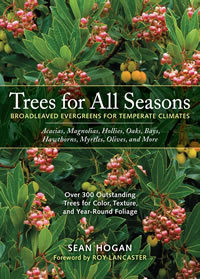 Portlander nurseryman Sean Hogan addresses a neglected part of the garden palette in “Trees for All Seasons: Broadleaved Evergreens for Temperate Climates”. And he does it with great enthusiasm; being quite candid that one of his goals is increased planting of these excellent but underused plants.
Portlander nurseryman Sean Hogan addresses a neglected part of the garden palette in “Trees for All Seasons: Broadleaved Evergreens for Temperate Climates”. And he does it with great enthusiasm; being quite candid that one of his goals is increased planting of these excellent but underused plants.
First, he defines his scope. Conifers, or monocots such as palms, are not included. He’s also strict about evergreen, subjects must “…keep their leaves year-round, or nearly so, but also remain attractive while doing so.” Icons with each entry give size and shape, and emphasize these are trees, not shrubs (he’s saving those for his next book).
The typical A-Z encyclopedia — with some bunching of closely related genera — is written for horticulturists (not botanists!) in temperate zones, and gives considerable gradation to the cold-hardiness and other exacting, cultural needs. For example, I learned that a favorite tree of mine from trips to the southwest, the Texas mountain laurel (Sophora secundiflora) would “…experience imperceptibly slow growth, or even lose ground…” in my Seattle garden without heroic efforts to match its preferred “swamp-cooler” climate.
Always the nurseryman, Hogan gives detailed notes about propagation and the habits of young nursery stock, always written in an easy to understand manner. Need to propagate your olive? Historically this was done by “chopping the heavily burled bases into pieces, pulling chunks out of the ground, then dragging them to the next area where, eventually, an olive tree would grow.” He goes on to say that with less effort similar results can be obtained from well-ripened cuttings with a high…ish level of hormone…along with a steep wound.”
This book will certainly enhance your appreciation of the Arboretum’s collection of broadleaved evergreens.
Excerpted from the Fall 2009 Arboretum Bulletin.